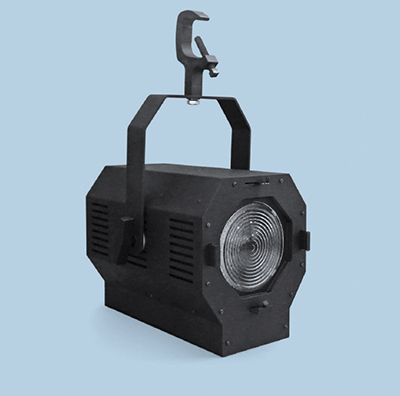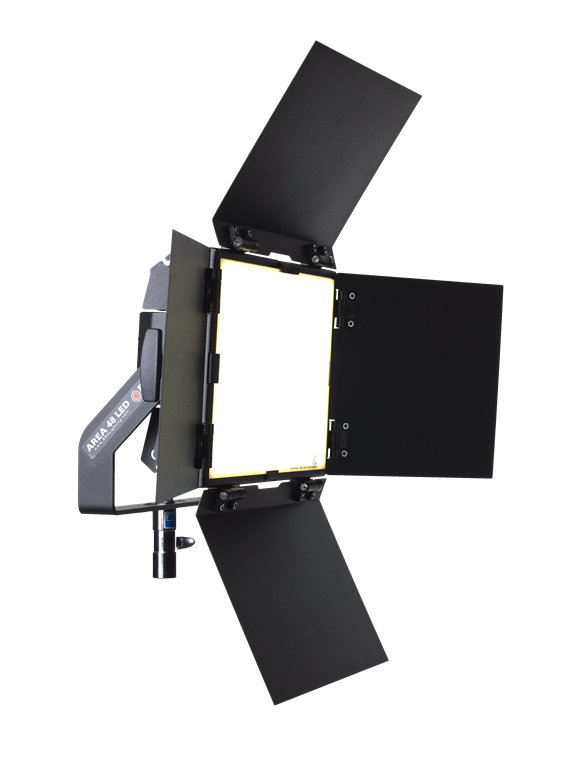Lighting Advances Focus on Size, Efficiency

Videssence’s new Vidnel 100 LED Fresnel uses a 100 W lamp that can replace a 1,000 W conventional quartz fixture.
SEATTLE—Visitors to recent NAB or IBC shows have witnessed many new developments in the manufacturing of professional lighting equipment and fixture designs. Some of these supposedly new designs are just packaging, but there’s a lot R&D going on in the lighting arena as well.
Where some lighting professionals have been happy with the quality of light they were getting from traditional tungsten, HMI and fluorescent fixtures, they have asked for features that come only with LED lighting equipment.
“Within the family of products we make in the fluorescent line, we’ve added LEDs over time,” said Scott Stueckle, sales and public relations manager at Kino Flo Lighting Systems in Burbank, Calif.
Kino Flo’s target was to design LED fixtures with the same quality of light, soft and diffuse, as its fluorescent banks, but with the long bulb life of LEDs. “And you also have low energy and color selection you can choose just by dialing in your color temperature, what color you need for the shot,” Stueckle said, adding that new cameras and lenses have driven the direction of this technology.
“A lot of people are tending more toward soft lighting because you get a lot of graduated density out of a soft light, from maybe very soft to a harder quality of soft light, and that shows up pretty dramatically in HD camera technology,” Stueckle said.
NEW CHIP DESIGN
Videssence is another pioneering fluorescent lighting fixture maker that cut its teeth in the energy-efficient television and video conference lighting business. Gary Thomas, national sales manager said the El Monte, Calif.-based company began with fixtures using multiple LED chips for soft lights, similar to their fluorescent bank lights.

Zylight’s new F8 LED Fresnel can be powered by a worldwide AC power adapter or a standard 14.4V camera battery. “LED technology has been changing rapidly,” he said. “Now that there is a powerful single source LED chip about the size of a quarter, we have a new Fresnel fixture that is a 100 W lamp that will replace a 1,000 W conventional quartz fixture. Color temperature, CRI rating, everything has gotten so much better with that technology.”
The professional video industry's #1 source for news, trends and product and tech information. Sign up below.
Thomas said the new Fresnel LED fixture fulfills an important lighting need. “With multiple source LED lights, you couldn’t do shadow contouring, barn doors would not work properly, you would have multiple shadows and shadow imaging.” Internally, the lensing and focusing mechanism is identical to legacy Fresnel fixtures. “It’s a fixture that looks like old technology but it’s powered by new technology and uses a tenth the electricity.”
The energy efficiency in both power draw and reduction in air conditioning needs are well-known characteristics of LED lighting, and are often touted when compared to the tungsten fixtures they replace in a studio. Litepanels, a Van Nuys, Calif.-based lighting vendor, cites a recent customer who found sizable infrastructure cost savings where a direct comparison was possible.
Station group Griffin Communications was planning to build a new Tulsa home for CBS affiliate KOTV, but they updated their plans when LED lighting because a viable alternative, according to Chris Marchitelli, vice president for global marketing for the Vitec Group, parent company of Litepanels. “Redesigning the studios for LED lights instead of a tungsten and fluorescent mix provided them with a real-world apples-to-apples comparison,” Marchitelli said. “There was quite a ripple effect.”
The reduction in heat load meant smaller air conditioning ducting, which allowed lower studio ceilings, which required less steel. That meant less overall weight, which also allowed a reduction in concrete in the foundation. “It was a substantial savings, above and beyond the ongoing energy savings,” said Marchitelli.
SAVING SPACE
“Run and gun” is a way of life for many videographers, whether for TV news or other work. “Their crews, if they have them, are getting smaller and their budgets are shrinking,” said Charlie Collias, director of sales at Zylight in Hillsboro, Ore. “They need good lighting that they can put up quickly and easily.”
This led Zylight to incorporate features like variable color temperature, variable color correction, full color output and wireless controls in their lighting products. “We have come out with a very space saving design, compact, a very small case that saves money on baggage fees when traveling,” Collias said. “It’s also weatherproof to protect the lights when the weather turns nasty.”
Zylight has also future-proofed its fixtures. “The lights are upgradable, so you can use them for years without worrying about them going out of style. You can mount a brighter module inside when one comes to market. So the users that we find are looking for small, compact instruments with a lot of features.”

K5600’s Joker Bug 200 Traditional LED fixtures rely on phosphors that are applied right on the LED bulb. Remote phosphor technology separates the phosphors from the LEDs. BBS Lighting places the LEDs behind a remote polycarbonate phosphorized diffuser on its Area 48 lighting fixture.
Ken Fisher, director of lighting for BBS Lighting, points to some of the advantages for remote phosphor technology in LED lighting. “There are a lot of the inherent problems with the traditional LED construction that go away when you move to the remote phosphor approach,” he said. “One is that applying the phosphors on the bulb itself is a precision task, where applying them to a much larger remote location is easier to manufacture and results in more consistency.”
Putting some distance between the LEDs and the phosphors also reduces the damage heat does to the phosphors. And in BBS’s Area 48 design, with the phosphors applied to a removable diffuser, different diffusers with different phosphor coatings can be used to achieve various color outputs.
HMI AND PLASMA
HMI lighting technology premiered decades ago and still has an important place in providing continuous spectrum, powerful daylight illumination in a variety of form factors. Location lighting fixture provider K5600 touts a major advance with its new 3200K discharge lamps that can be easily changed out with HMI 5600K lamps.
“There have been ways in the past where you’ve been able to unplug and change out different components,” said Ryan Smith, president of K5600 USA in North Hollywood, Calif. “But this will be the first time where you can just swap bulbs and still get a highly efficient lighting instrument with the appropriate color temperature for all practical purposes on the set.”
The ballast and other electronics will remain the same regardless of which bulb is used. “So for all our existing fixtures on the market—200, 400, 800 W fixtures— you’ll be able to swap lamps and get a 3200K color at the same efficiencies that HMIs are currently producing; four or five times as efficient as a tungsten lamp.”

BBS Lighting places the LEDs behind a remote polycarbonate phosphorized diffuser on its Area 48 lighting fixture.
While most of the buzz in lighting technology has been around LED light sources, there’s a new kid on the block in the form of plasma bulbs. Jon Miller, founder and CTO for Los Angeles-based Hive Lighting explained how plasma lighting works: “We put a small amount of gas in a quartz capsule, and basically microwave it. That produces a plasma state, and that produces a ton of photons, a lot of light from a small point source.”
He said the quality of the daylight-balanced light produced is different from the discontinuous, or spiky spectrum from LEDs. “It provides with a full spectrum light, with the spike in the yellow arc, much more like direct sunlight, as opposed to spiking in the green that you’ll see in HMIs, and in certain fluorescents and LEDs,” he said.
The fact that all the light comes from a small glass capsule makes it possible to use classic Fresnel and parabolic optical designs to operate as daylight sources with the plasma bulbs, roughly doubling the output of an HMI fixture with equivalent wattage. Today Hive has one plasma bulb size, 275 W. But Miller said they will expand to a range of bulbs, very much like present HMI fixture makers have.
